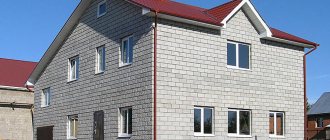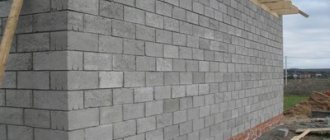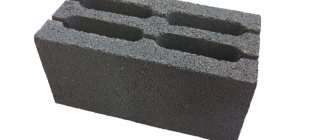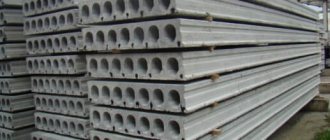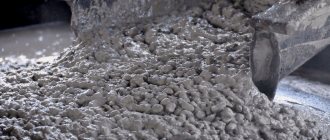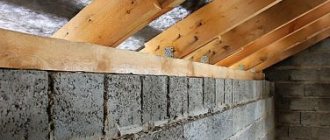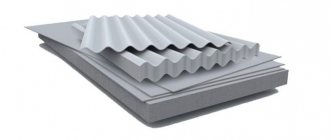Expanded clay concrete is used in the construction of external walls and ceilings. The material is lightweight and environmentally friendly, representing a subtype of lightweight concrete mass. Expanded clay concrete is considered completely safe; it is preferred in the construction of schools, children's institutions, hospitals, apartment buildings, and interior partitions. Walls made of such material are able to “breathe”, passing air masses through themselves, and do not accumulate moisture. The main component is expanded clay, to which binders are added in the form of cement mass, resin or gypsum. The blocks are durable, retain heat well indoors, do not react to temperature changes, and are easy to install. Today we’ll try to find out how much a cube of expanded clay concrete weighs in order to correctly determine the need for this material.
Specific gravity of one cubic meter of concrete
The most common way to classify the weight of a cubic meter of concrete mass is by specific gravity.
Taking into account the volumetric mass, concrete is divided into several types:
- Particularly light - the maximum weight of one cube does not exceed five hundred kilograms. Such concrete is characterized by the content of cells with air, the diameter of which is 1 - 1.5 mm, and a porous base. Such compositions include foam and gas block materials, which contain not only sifted sand and cement material, but also a foam former that forms air cells. This makes it possible to create a small mass and excellent thermal insulation abilities.
- Lightweight - concrete compositions filled with lightweight porous material. There may be no filler, but the structure of the mass still remains porous. A cube of material in this case weighs 500 - 1,800 kg, six hundred kilograms of which is sand - the main and essential element.
- Heavy is the most common type of mortar. It is used to make the main elements of the facility, screeds, fences, etc. The composition contains coarse fillers - sand, crushed stone, gravel, which account for the bulk of the material. A cubic meter of such concrete weighs from 1.8 to 2.5 tons.
- Particularly heavy - metal filler is used for its manufacture to give the finished product massiveness. One cube of material weighs from 2.5 to 3 tons. The composition includes a cement mass of increased strength. As a rule, special objects are built from such material.
As a rule, lightweight concrete is used in the form of a finished building block.
Advantages of expanded clay concrete
Over the course of several decades, expanded clay concrete has become popular not only in Europe, but also throughout the CIS, including Russia. The rapid growth in demand for the material is due to a number of advantages:
- Low price. Within their scope of application, expanded clay concrete blocks are one of the most affordable building materials, especially in comparison with wood.
- Strength. M75 brand blocks can be used to construct load-bearing walls of buildings up to three floors high. There are grades with higher strength, up to the M300 grade.
- Durability. The service life of expanded clay concrete blocks is comparable to that of brick. Under certain conditions, this period can reach 100 years.
- Low water absorption. The material does not absorb moisture well, so it is not able to destroy it from the inside. For the same reason, blocks are not suitable for mold growth.
- Environmentally friendly. The composition includes simple natural ingredients - water, expanded clay, cement and sand. Surfactants and other chemical additives are not used.
- Low specific gravity. This block parameter is 2-3 times smaller compared to the same brick. This allows you to save on the foundation of the house without losing its stability.
- Easy to install. Building a wall from expanded clay concrete blocks is much faster and easier, since its volume exceeds the volume of an average brick by approximately 7 times.
- Resistance to external factors. The building material resists chemical and biological influences well, and also does not catch fire and does not spread combustion.
- Low thermal conductivity of expanded clay concrete. According to this indicator, it is between brick and such popular building materials as foam concrete and aerated concrete.
Expanded clay concrete blocks go well with any known finishing materials. A large selection of elements of different shapes, including additional blocks, makes it possible to provide passages for natural ventilation and various communications even at the design stage.
Expanded clay concrete walls
Mass calculation
There is a special formula to determine the weight of concrete and expanded clay concrete
g bs = V cr g env + V p g op + 1.15C, in which:
g bs is the expected maximum volumetric mass of expanded clay concrete in a dry state, expressed in kg/m. cube;
g surrounding and g op are the masses of coarse and fine filler, kg/m. cube;
V cr and V p - consumption amount of coarse and fine aggregate per 1 cubic meter of laid concrete composition, cubic meters;
C - the amount of binder per 1 cubic meter of laid expanded clay concrete, kg.
To determine the mass of a block, you need to know its shape, dimensions and weight of the materials used for production. And if you take a block with parameters 20 x 20 x 40 cm, then its mass will be from 6 to 29 kg.
Expanded clay concrete is usually divided into three subtypes:
- thermal insulation;
- structural;
- structural and thermal insulation.
The weight of expanded clay concrete is determined by the pore size of the filler and its quantity in the concrete mass.
Specific gravity
We have analyzed how much a cube of thermal insulation and construction expanded clay concrete weighs. Specific gravity is the ratio of the volume of solid particles to their mass; very often this parameter is confused with density. The calculation is carried out in a dry state of the material. There are a number of factors that significantly affect specific gravity, the most important of which is grain size.
In industrial construction there are three fractions of this filler:
- Sand - the size of its fractions is 0–5 mm.
- Gravel - divided into 3 types: 5–10, 10–20, 20–40 mm.
- Crushed fraction - its size is 5–40 or 0–10 mm.
Why do we consider specific and volumetric gravity? The fact is that the choice of faction will determine how much a cube of this material holds. According to the state standard 9757-90, a grade corresponding to the density is set. For example, brand M250 has a volumetric weight of 250 kg/m 3.
It will also be useful to know the formula that can be used to obtain the maximum mass of expanded clay concrete:
- gbs - max possible volumetric weight of dry expanded clay concrete, kg/m 3 ;
- gк and gм - volumetric weight of coarse and fine aggregate, kg/m 3 ;
- Vk and Vm - consumption of coarse and fine aggregate per 1 m 3 of solution, m 3;
- C is the consumption of binder per 1 m 3 of mixed expanded clay concrete, kg.
To calculate the mass of expanded clay concrete, it is necessary to take into account the mass of materials that are used to create the solution, shape and size. For example, you can take standard blocks 200x200x400 mm; they can weigh from 6 to 30 kg. Their volumetric mass will be about 300 kg per cubic meter.
Volume weight
The mass of materials used depends on the characteristics of their application:
- for the construction of an external wall;
- under the floor screed;
- for attic insulation.
When expanded clay concrete is used as an insulating material, sand should not be added. The composition includes cement mass, clean water, expanded clay stone of large and light fractions. The output is from 500 to 550 kg per cubic meter - exactly what is required to insulate the wall. Adding sand will add heaviness and reduce the level of thermal conductivity. To prepare one cubic meter of expanded clay concrete, you will need 280 kg of cement composition, the grade of which is m400. Knowing the initial data, you can determine how much a cube of m300 concrete with expanded clay weighs.
To produce lightweight expanded clay concrete, it is allowed to add sawdust of coniferous wood varieties to the mass.
The strength and weight of the material will depend on the amount of cement in expanded clay concrete.
To prepare the solution, you will need the following components:
- cement composition;
- washed sand;
- expanded clay stone;
- pure water;
- plasticizer additives in the form of liquid soap or washing powder.
The specific gravity of dry expanded clay concrete is the ratio of the weight of the dry material to the entire volume. It all depends on the size of the expanded clay grains. As already mentioned, the mass of expanded clay concrete is determined by the level of porosity of the material and the amount of its volume in the concrete mass.
The lightness of the components has an impact on reducing the costs associated with transporting the material and reduces the cost of the finished product.
Volumetric weight or overall size of blocks
This concept refers to the weight of blocks that occupy a certain volume, for example one cubic meter. Depending on the density of the concrete, the blocks have different weights, so one cube of thermal insulating concrete is much lighter than structural concrete. The blocks that are used for thermal insulation have the lowest volumetric weight - it varies in the range from 500 to 900 kg/m3. This type does not require high reliability and strength, and it does not create excessive load on load-bearing walls and partitions.
As for the structural type, its cube weighs from 1400 to 1900 kg/m3 . The indicators of structural and thermal insulation expanded clay concrete should vary from 900 to 1400 kg/m3. Typically, in industrial construction, blocks with optimal weight are selected, which will not make the structure too heavy, but will still provide sufficient strength. For example, in panel houses today they most often use 800 kg/m3.
Separately, it is worth considering the structural appearance. It has the highest strength when compared with other types, while its bulk density is quite low. This is due to the fact that in construction this type is used to lighten the load-bearing structure. It is also worth mentioning about the compressive strength, which ranges from 200 to 400 kg/cm2. If necessary, structural expanded clay concrete is reinforced; for this, both conventional and stressed reinforcement are used. The second type can be used with grade M200 or higher. In some situations, it is necessary to increase elasticity and strength - for this, quartz sand is used, which is added when making the solution.
When choosing a suitable material for building a house, it is recommended to use more durable grades, since private houses are usually built on 2-3 floors. In any case, the optimal brand will be 900–1200 kg/m3.
Characteristics of building materials
Expanded clay is considered the lightest type of porous bulk raw material. Due to the presence of pores with air, the material demonstrates high heat/sound insulation properties. Different fractions of expanded clay have their own limits for a certain brand - the density and weight of expanded clay concrete depend on the size and volume of gravel in the composition.
Currently reading: Granite concrete
Types of expanded clay granules for the production of material: Sand - particles 0-5 millimeters in size. Gravel - there are three main types: 5-10 millimeters, 10-20 and 20-40 millimeters. Crushed stone from expanded clay - 0-10 or 5-40 millimeters .
Despite the low density of expanded clay, it shows optimal values of mechanical strength - resistance to high loads is ensured by the internal structure of clay granules. All technical characteristics are directly related to the brand - the larger the number next to the M index, the larger all the values.
Brands of expanded clay concrete and their technical characteristics: M100 - frost resistance at the level of F50-F100, water resistance in the range W2-W4, density from D900 to D1300, strength class B7.5. M150 - frost resistance at the level of F75-F100, water resistance W4, density from D1000 to D1500, strength class B10-B12.5. M200 - frost resistance at the F100 level, water resistance in the W4 region, density D1600, strength class B15.
The main feature of expanded clay concrete is its low weight with fairly high strength. The material is considered universal; it can be used in creating various structures, pouring floors, and performing certain elements.
Expanded clay concrete demonstrates good insulating properties, withstands long-term loads, is not afraid of aggressive environments, water, and is easy to work with (lightweight, does not require vibration). The main advantages of expanded clay concrete: Light weight, which reduces the overall load of the building on the foundation and structural elements, facilitates and reduces the cost of installation, implementation of pouring work, etc. Increased resistance to fire, which is especially important for residential and industrial buildings. Environmental friendliness and safety for health, well-being, people's lives. High rates of thermal insulation, sound insulation. Low value of water absorption, the ability to create an optimal microclimate in the room. Reduced need for concrete solution. Accelerated completion of work (on average 5 times, as indicated by the craftsmen).

